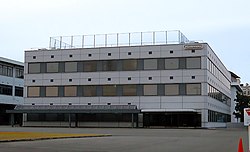| Nintendo's logo, used during R&D2's existence | |
 Exterior of the former Nintendo headquarters in Kyoto, Japan, which housed the department | |
Native name | 任天堂開発第二部 |
|---|---|
Romanized name | Nintendō Kaihatsu Daini Bu |
| Company type | Department |
| Industry | Video games |
| Genre |
|
| Predecessor | Nintendo Research & Development |
| Founded | 1978 |
| Founder | Hiroshi Yamauchi |
| Defunct | 2004 |
| Fate | Absorbed into Nintendo Software Planning & Development |
| Successor | Nintendo Software Planning & Development |
| Headquarters | Kyoto , Japan |
Number of locations | 1 (Kyoto) (2004) |
Key people |
|
| Parent | Nintendo Manufacturing Division |
Nintendo Research & Development No. 2 Department, [a] commonly abbreviated as Nintendo R&D2, was a Japanese team within Nintendo that developed software and peripherals. While usually occupied in system operating software and technical support, the team would come back to early development in the 1990s where several new designers got their start at game development, the most famous being Eiji Aonuma who developed Marvelous: Another Treasure Island.
Contents
- History
- Products developed
- Electronic games
- Video game consoles
- Video games
- Notes
- References
- External links
The team was formed as a spin-off of the older Nintendo Research & Development No. 1 Department and was initially led by Masayuki Uemura, who previously worked for Sharp Corporation. Using an idea of Sharp's solar technology, Uemura's department went on to develop the popular Nintendo beam gun games, selling over 1 million units. Kazuhiko Taniguchi took Uemura's position in 2004. Nintendo R&D2 was later merged into Nintendo SPD. [1]